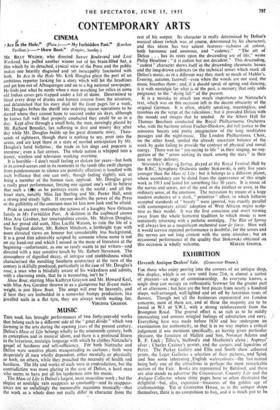MUSIC
THIS week has brought performances of two forty-year-old works that belong each to a different side of the " great divide " which was forming in the arts during the opening years of the present century. Delius's Mass of Life belongs wholly to the nineteenth century, both in conception and in musical idiom, and there is a profound fitness in the luxurious, nostalgic language with which he clothes Nietzsche's gospel of hardnesi and self-sufficiency. FOr both Nietzsche and Delius were sensitive plants masquerading as cactuses ; both were desperately ill men wholly dependent, either mentally, or physically or both, on others, while they preached the necessity of health and hardness. The life and works of each were in contradiction, but the contradiction was more glaring in the case of Delius, a hard man who seems to have put all his tenderness into his music. The Mass of Life is Delius's largest, most masculine work ; but the elegiac or nostalgic vein reappears so constantly—and its reappear- ances are so unfailingly the memorable occasions musically—that the work as a whole does not really differ In character from the rest of his output. Its character is really determined by Delius's musical idiom (which was, of course, determined by his character), and this idiom has two salient features—richness of colour, both harmonic and sonorous, and " cadency." " The art of Delius . . . has its roots upon the descending arc of life," wrote Philip Heseltine ; "it is cadent but not decadent." This descending, " cadent " character shows itself in the descending chromatic basses and the long-drawn cadences (in the technical sense) which mark all Delius's music, as in a different way they mark so much of Mahler's. Evening, autumn, farewell—even when the words are not used, the music breathes them ; and, if it should speak of spring and dancing, it is with nostalgia for what is of the past, a memory that only adds poignancy to the " dying fall " of the present.
It is a mistake to attach too much importance to Nietzsche's text, which was on this occasion left in the decent obscurity of the original German. It is often, strictly speaking, meaningless, and trembles on the verge of the ridiculous ; but it provided Delius with he moods and images that he needed. At the Albert Hall Sir Thomas Beecham conducted the Royal Philharmonic Orchestra who, with the baritone soloist Fischer-Dieskow, did full justice to the sensuous beauty and poetic imagination of the long meditative passages and the night-music. The London Philharmonic Choir, on the other hand, spoiled the already uncertain balance of the - work by quite failing to provide the contrast of physical and moral energy. There was no " yea-saying to life " in their singing, no sug- gestion of the " arrow seeking its mark among the stars " in their tone or their delivery.
Stravinsky's Rite of Spring. played at the Royal Festival Hall by the B.B.C. Symphony Orchestra under Stokowski, is only five years younger than the Mass of Life ; but it belongs to a different planet. whose ascendancy can be dated from the appearance of this single work in 1913 and lasted for something like 30 years. It is music of the nerves and senses, not of the soul or the intellect or even, in the ordinary sense, of the emotions. The recreation by means of a huge modern orchestra of a stark, " primitive " effect, in which hitherto accepted standards of " beauty " were ignored, was exactly parallel with contemporary artists' adoption of West African negro sculp- ture as their model. It was the first conscious and overt turning away from the whole humanist tradition to which music is now tentatively returning with a pathetic nostalgi;. The Rite of Spring will always live as a magnificent orchestral tour de force. How well it would survive repeated performance is doubtful, for the senses and the nerves are not long content with the same stimulus ; but an occasional performance of the quality that Stokowski obtained on
this occasion is wholly welcome. MARTIN GUOPER.


































 Previous page
Previous page